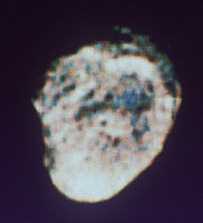This is an image of Rhea.
Click on image for full size
NASA/JPL
Saturn's Moons and Rings
The planet Saturn has a lot of moons. It has a total of
moons!
Saturn also has huge rings which
you can see in any picture of Saturn.
One of Saturn's moons is named Titan.
Titan is a very big moon. Most moons don't have any air, but Titan does! The
clouds on Titan are orange.
One of Saturn's moons looks like the "Death Star" from the Star Wars movies. It
is called Mimas. Another moon has one white
side and one black side. That odd moon is called Iapetus.
Some of Saturn's moons are medium-sized and some are very
small. The names of the other medium-sized moons are Rhea, Dione, Tethys, Enceladus, Hyperion, Phoebe, Janus and Epimetheus.
Some old myths are about people and gods who have the same names as some of
Saturn's moons.
You might also be interested in:

Titan is a moon of the planet Saturn. It is Saturn's largest moon. Titan is the second largest moon in the whole Solar System. It is larger than Earth's moon. It is even larger than two planets - Mercury
...more
Rhea was discovered by G. Cassini in 1672. Rhea is the 5th farthest moon from Saturn. Rhea is one of the icy moons. Rhea is about as wide as the state of California is long. Rhea is has many craters and
...more
Dione was discovered by G. Cassini in 1684. Dione is the 7th farthest moon from Saturn. It is a small icy moon, lightly cratered, with white streaks across the surface. Dione is about as wide as the Oregon
...more
Tethys was discovered by G. Cassini in 1684. Tethys is the 8th closest moon to Saturn. Tethys is one of the icy moons. It is about as wide as the length of the Oregon coast. Tethys is has a surface, with
...more
Saturn has // Call the moon count function defined in the document head print_moon_count('saturn'); moons. Enceladus is one of them. Enceladus is the sixth biggest moon of Saturn. The diameter of Enceladus
...more
Hyperion was discovered by W. Bond in 1848. Hyperion is the 3rd farthest moon from Saturn. Hyperion is about the size of a large county or small state. One of the main things about Hyperion is its unusual
...more
Titan is the largest moon of Saturn. Titan has a very thick atmosphere. That makes it hard to "see" the surface of Titan. In the past, we didn't know much about the surface of Titan. Starting
...more
This is an image of the Earth's moon, shown in the lower left, with the icy moons of Saturn. The moons in order, starting from the top left are: Mimas, Enceladus, Tethys, Dione, Rhea, and Iapetus.
...more














